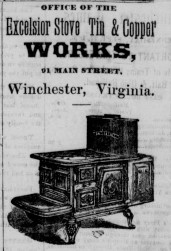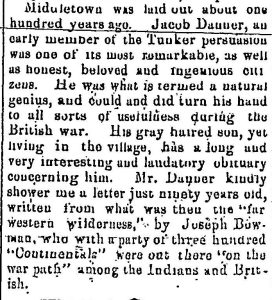While working on another research project this week, we came across an article referencing Marlboro Furnace and the production of firebacks, which was discussed in our “West of the Blue Ridge” series on metalworking. While we found it too late to reference in that post, we thought it would make a nice addendum and have reprinted the text here:
PERHAPS OLDEST EXTANT.
A “Fireback” Made in 1755—A Curio Worth Possessing.
Friday morning while in the shop at Reed and Nulton’s, on west Water street, a Times reporter spied an ordinary and rough-looking piece of old iron, which would have escaped the notice of many. His attention was drawn to it by seeing the name of an old German family among his ancestors, and naturally he investigated. The curio was a “fireback,” so common in the houses of colonial days and is one of a few relics of this character extant in this community.
These “firebacks” resemble the sides of a large “ten-plate” stove and were used in fire places by the old timers. Most of them in this section were made by the old Marlboro Furnace, in this county, with which the Zane family was connected. One is now in the possession of the Sarah Zane Fire Company, which was made for the Cartmell’s, ancestors of our worthy county clerk.
The “fireback” seen this morning was made in 1755 for the Huber family—now called Hoover, of which Mr. C. F. Hoover is one of the many representatives—and also represented by a family of Hubers in Stephens City. On the plate is some figured work either allegorical or characters the result of the ingenuty [sic] of the iron moulder [sic]. The name upon it is
“JACOB HVBER,
“1ST DER FRST DE
“1755.”
Mr. Nulton also has the portion of another aged plate and there are several more in the community.
The writer of this article has one at his residence which is used in lieu of a stepping stone.
The Huber “fireback” was secured by Mr. Nulton from a party who once resided in the house on Braddock street now occupied by Mr. George Thatcher, and it is probably the oldest of its kind in the country.
In connection with this we append an article from Ironmonger and would further state that the “fireback” referred to was in his possession once and he claims it was loaned to a late resident of this city:
“As matter of historic interest I give herewith a representation of an anti-Revolutionary stove which is now in possession of Mr. Charles B. Hotchkiss, the New York manager of the Barstow Stove Company, who feels peculiar pride in possessing this old relic of his business.
“Discussion has been so warm, I have taken the trouble to obtain from the gentleman who formerly possessed this plate, some data as to its history. Under date of April 18th he writes from Winchester, Va., as follows:
‘The fireback referred to, with another like it, was bought from a stove dealer here, who was only willing to say that the owners who had placed it in his hands to sell, ‘stood on their dignity’ (in his words), and did not care to be known, being in reduced circumstances.
‘Marlboro Furnace, long cold, I have always understood was in this county, a few miles southeast from Winchester. A post office still bears the name. It could hardly be called a stove foundry, but cast some stoves I suppose, like other old charcoal furnaces in the valley. Probably no flasks were used, the metal being run into bedded molds in the sand, like pig iron, direct from the blast furnace. You can better judge of that than I. The iron is said to he tougher than what is commonly made now.
“Frederick county was erected in 1737 or ’38, and Winchester in 1752. Fort Loudoun, through which our main, or Loudoun street runs, was built in 1756, by Col. Geo Washington, who, two years later, at the age of 26, was elected by Frederick county, her delegate to the House of Burgesses. The embankment is still distinct, and the well, sunk 102 feet by Washington, still yields such pure and cold water as Croton Lake never sent to New York There is a square here bounded on one side by Washington street, so named at that time, and the first thing ever called after him.’
“So you see casting might very well have been done hereabouts in 1768 I have seen no others dated so old; but many stoves, a century or so old, are, I think, to be found in this quarter. You now have all I know in the premises.” —Winchester Times, Volume 34, Number 25, 8 March 1899










